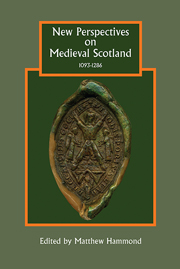Book contents
- Frontmatter
- Contents
- List of illustrations and tables
- List of contributors
- Acknowledgements
- Abbreviations
- Maps
- 1 Introduction: The paradox of medieval Scotland, 1093–1286
- 2 The Scottish ‘political community’ in the reign of Alexander II (1214–49)
- 3 Homo ligius and unfreedom in medieval Scotland
- 4 Scottish royal government in the thirteenth century from an English perspective
- 5 Neighbours, the neighbourhood, and the visnet in Scotland, 1125–1300
- 6 Cistercian identities in twelfth- and thirteenth-century Scotland: the case of Melrose Abbey
- 7 The language of objects: material culture in medieval Scotland
- 8 Structuring that which cannot be structured: a role for formal models in representing aspects of medieval Scotland
- Bibliography
- Index
- STUDIES IN CELTIC HISTORY
8 - Structuring that which cannot be structured: a role for formal models in representing aspects of medieval Scotland
Published online by Cambridge University Press: 05 August 2013
- Frontmatter
- Contents
- List of illustrations and tables
- List of contributors
- Acknowledgements
- Abbreviations
- Maps
- 1 Introduction: The paradox of medieval Scotland, 1093–1286
- 2 The Scottish ‘political community’ in the reign of Alexander II (1214–49)
- 3 Homo ligius and unfreedom in medieval Scotland
- 4 Scottish royal government in the thirteenth century from an English perspective
- 5 Neighbours, the neighbourhood, and the visnet in Scotland, 1125–1300
- 6 Cistercian identities in twelfth- and thirteenth-century Scotland: the case of Melrose Abbey
- 7 The language of objects: material culture in medieval Scotland
- 8 Structuring that which cannot be structured: a role for formal models in representing aspects of medieval Scotland
- Bibliography
- Index
- STUDIES IN CELTIC HISTORY
Summary
Computing offers something of a paradox when it comes to historical studies. On one hand, one suspects that almost all academic historians in at least Western Europe and North America have a computer both in their office and at home and use it daily for email, word processing, and for surfing the World Wide Web. However, in spite of their daily contact with the machine, they view it as having little or nothing to do with the essence of their research. Now, the fact that historians use the computer every day as a part of their research activities, but both hardly notice it and probably do not often think that it actually affects what they do, turns out to be an interesting phenomenon that is, of course, not restricted to the field of history. Indeed, the ability of tools such as word processing, email, and the WWW to fit into the normal way of doing things so that they are almost invisible reveals an aspect to computing that is significant in its own right. However, this chapter presents an example of a more prominent role for the computer in the doing of history. We focus on one of the ways in which computing obviously significantly impacts on the research: representing the product of historical research as highly structured materials in databases, and use the Paradox of Medieval Scotland project as the prime example.
- Type
- Chapter
- Information
- New Perspectives on Medieval Scotland, 1093-1286 , pp. 203 - 214Publisher: Boydell & BrewerPrint publication year: 2013

